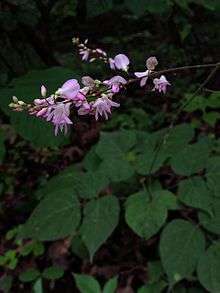Hylodesmum glutinosum
Hylodesmum glutinosum is a species of flowering plant in the family Fabaceae. Common names include large tick-trefoil, clustered-leaved tick-trefoil, large-flowered tick-clover, pointed tick-trefoil, beggar's lice and pointed-leaved tick-trefoil.[1][2] It occurs in eastern Canada, the central and eastern United States, and northeastern Mexico.[3]
| Hylodesmum glutinosum | |
|---|---|
 | |
| In Fairfax County, Virginia | |
| Scientific classification | |
| Kingdom: | Plantae |
| Clade: | Tracheophytes |
| Clade: | Angiosperms |
| Clade: | Eudicots |
| Clade: | Rosids |
| Order: | Fabales |
| Family: | Fabaceae |
| Genus: | Hylodesmum |
| Species: | H. glutinosum |
| Binomial name | |
| Hylodesmum glutinosum (Muhl. ex Willd.) H.Ohashi & R.R.Mill | |
| Synonyms | |
| |
Taxonomy
First described in 1802 as Hedysarum glutinosum and sometimes considered part of the genus Desmodium, it was transferred to the new genus Hylodesmum (tribe Desmodieae) in 2000.[4]
gollark: > Cherenkov radiation (/tʃəˈrɛŋkɒf/;[1] Russian: Черенков) is electromagnetic radiation emitted when a charged particle (such as an electron) passes through a dielectric medium at a speed greater than the phase velocity of light in that medium. A classic example of Cherenkov radiation is the characteristic blue glow of an underwater nuclear reactor. The phenomenon is named for Soviet physicist Pavel Cherenkov, who shared the 1958 Nobel Prize in Physics for its discovery. (praise wikipedia, etc)
gollark: ???
gollark: Neutrinos are not charged.
gollark: Ah, it's specifically CHARGED particles, I checked.
gollark: No, I mean is Cherenkov radiation not... caused by alpha/beta radiation, not neutrinos?
References
- "Hylodesmum glutinosum (Muhlenberg ex Willdenow) H. Ohashi & R.R. Mill - Database of Vascular Plants of Canada (VASCAN)". data.canadensys.net. Retrieved 2020-01-19.
- "Tropicos | Name - Hylodesmum glutinosum (Muhl. ex Willd.) H. Ohashi & R.R. Mill". www.tropicos.org. Retrieved 2020-01-20.
- "Hylodesmum glutinosum (Muhl. ex Willd.) H.Ohashi & R.R.Mill". Plants of the World Online. Royal Botanic Gardens, Kew. Retrieved 20 January 2020.
- "Hylodesmum glutinosum". International Plant Names Index (IPNI). Royal Botanic Gardens, Kew. Retrieved 2018-01-19.
This article is issued from Wikipedia. The text is licensed under Creative Commons - Attribution - Sharealike. Additional terms may apply for the media files.